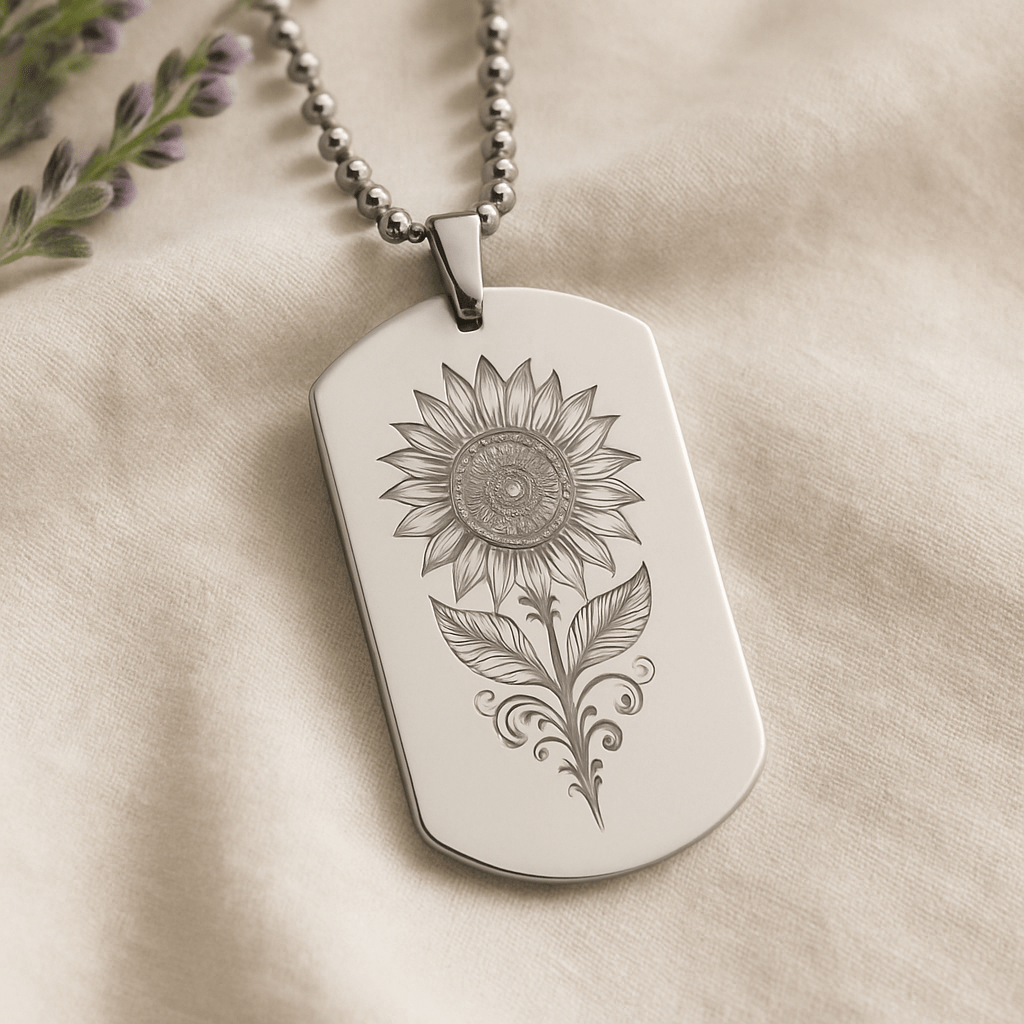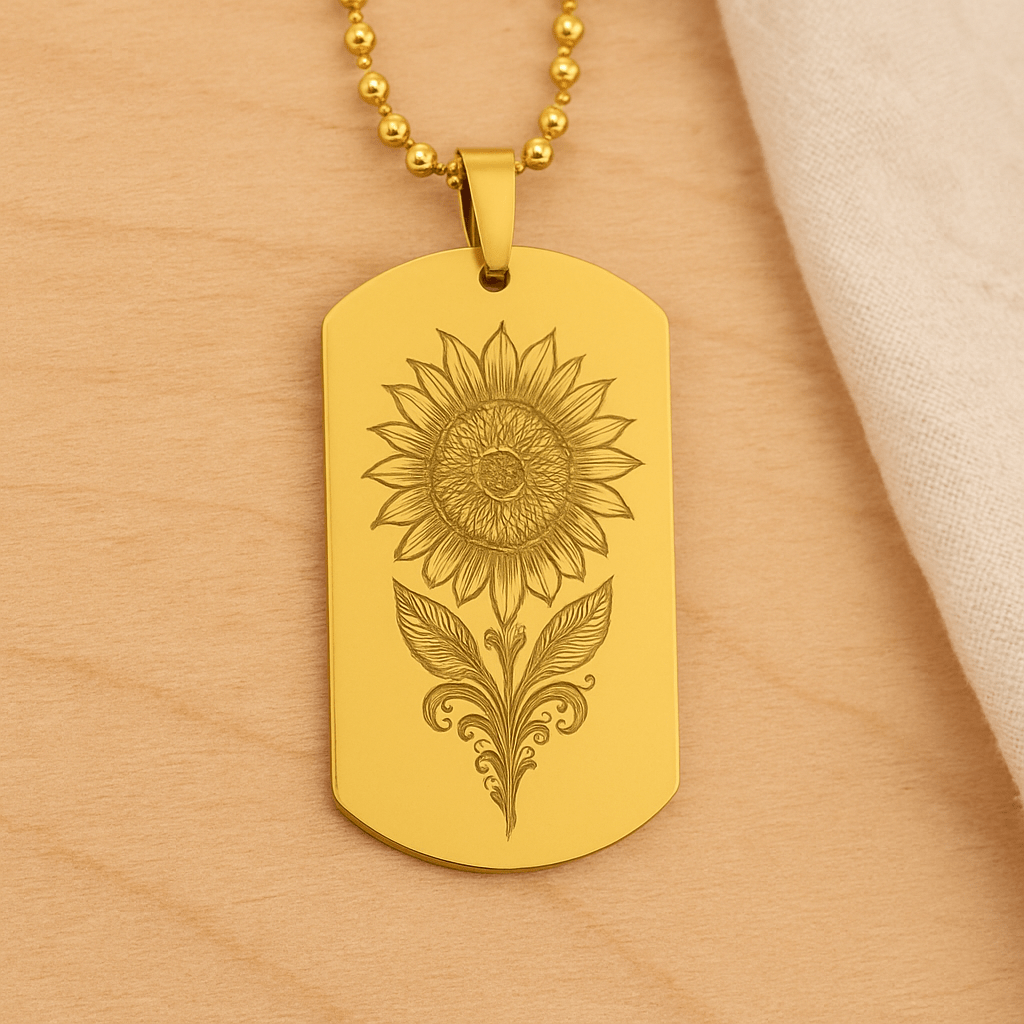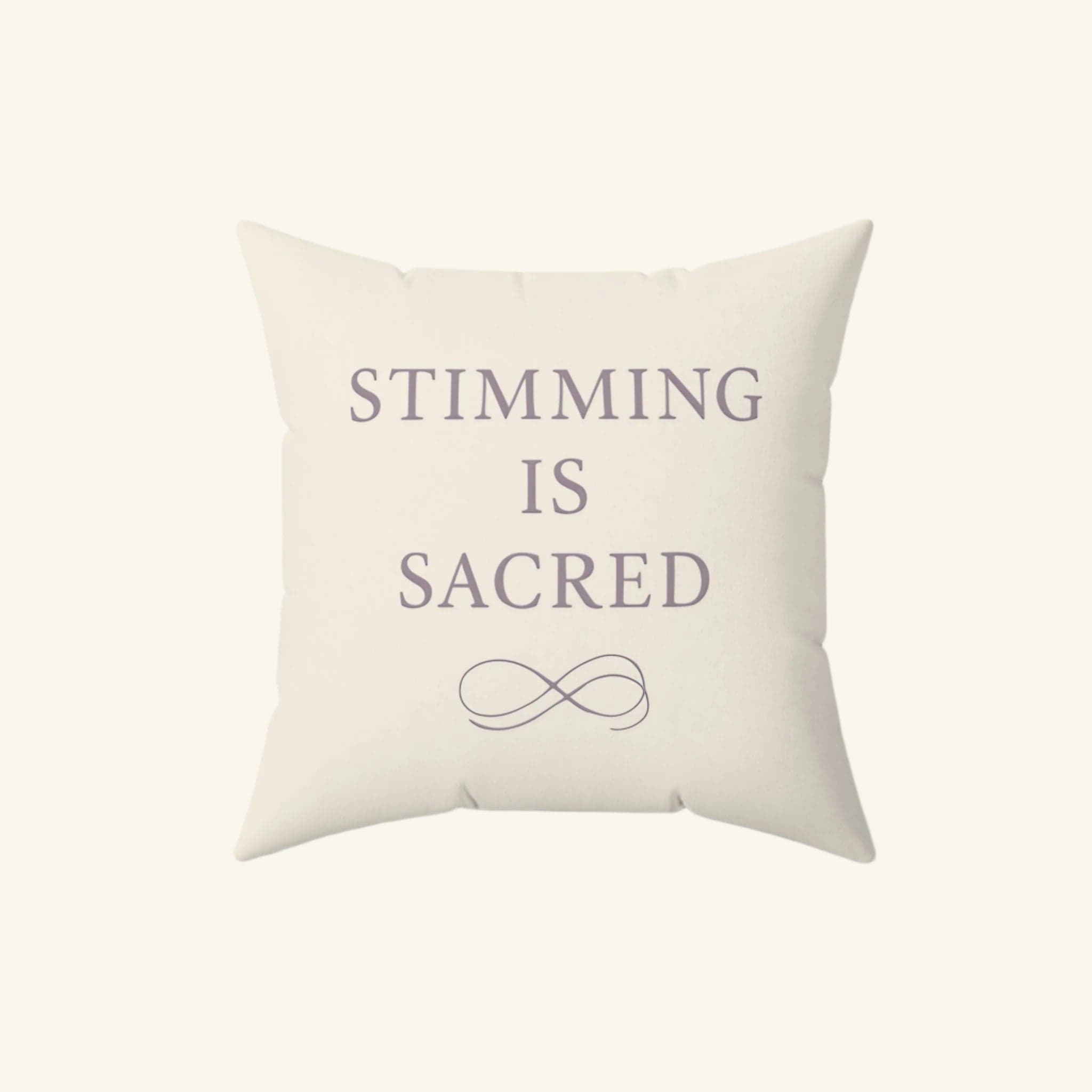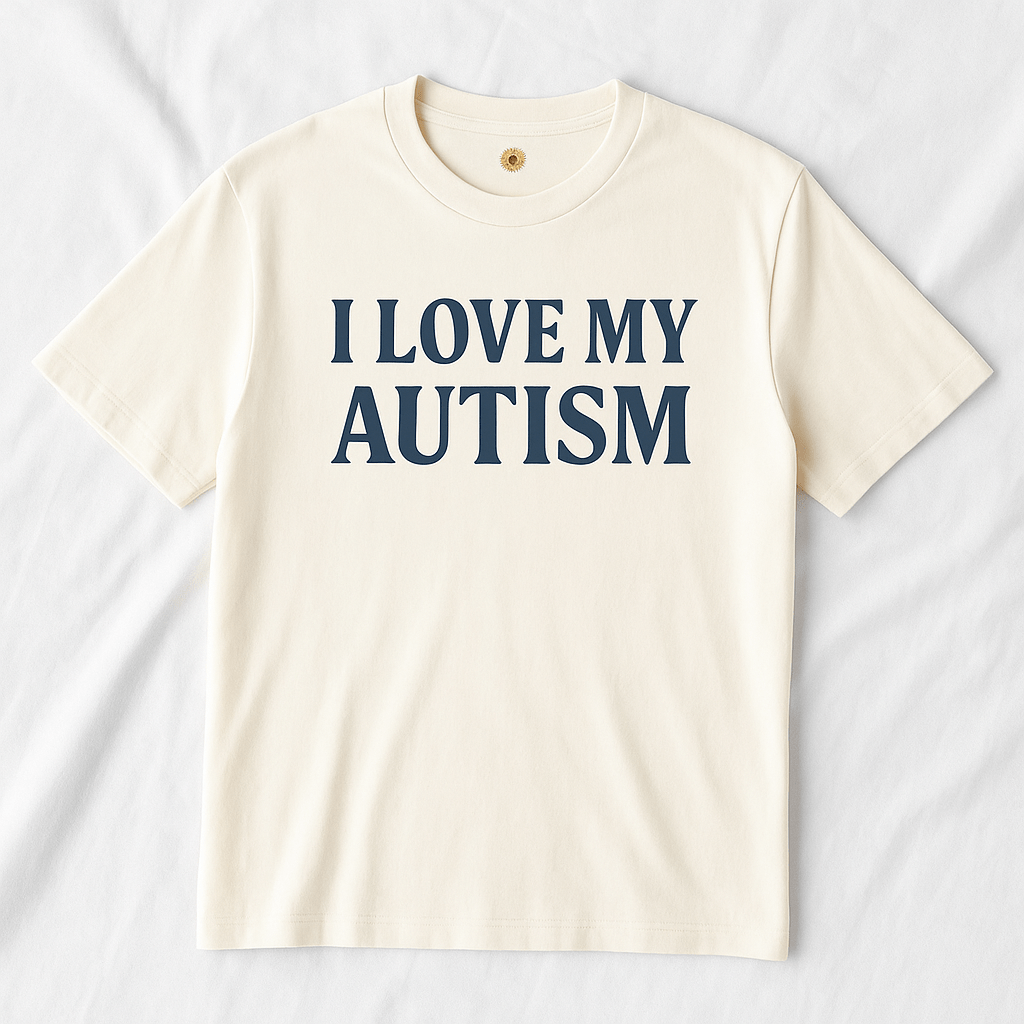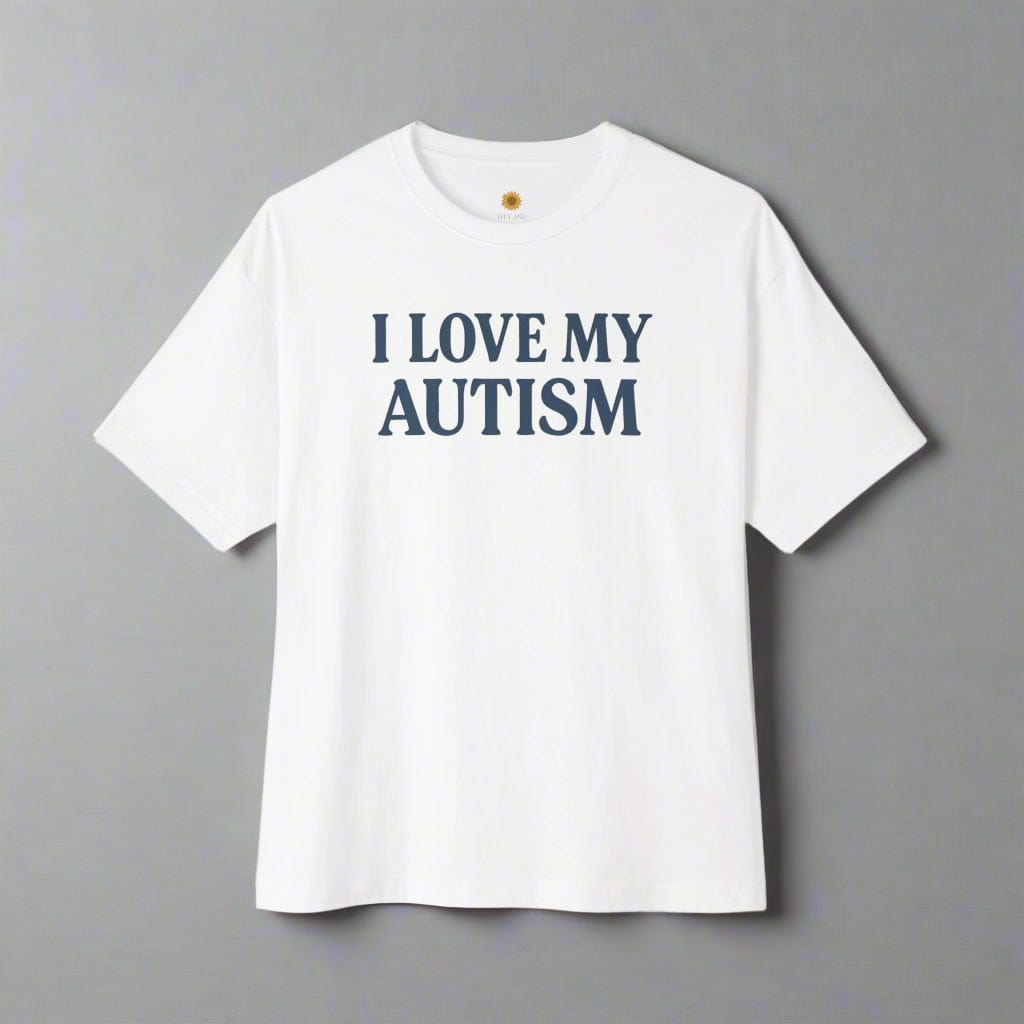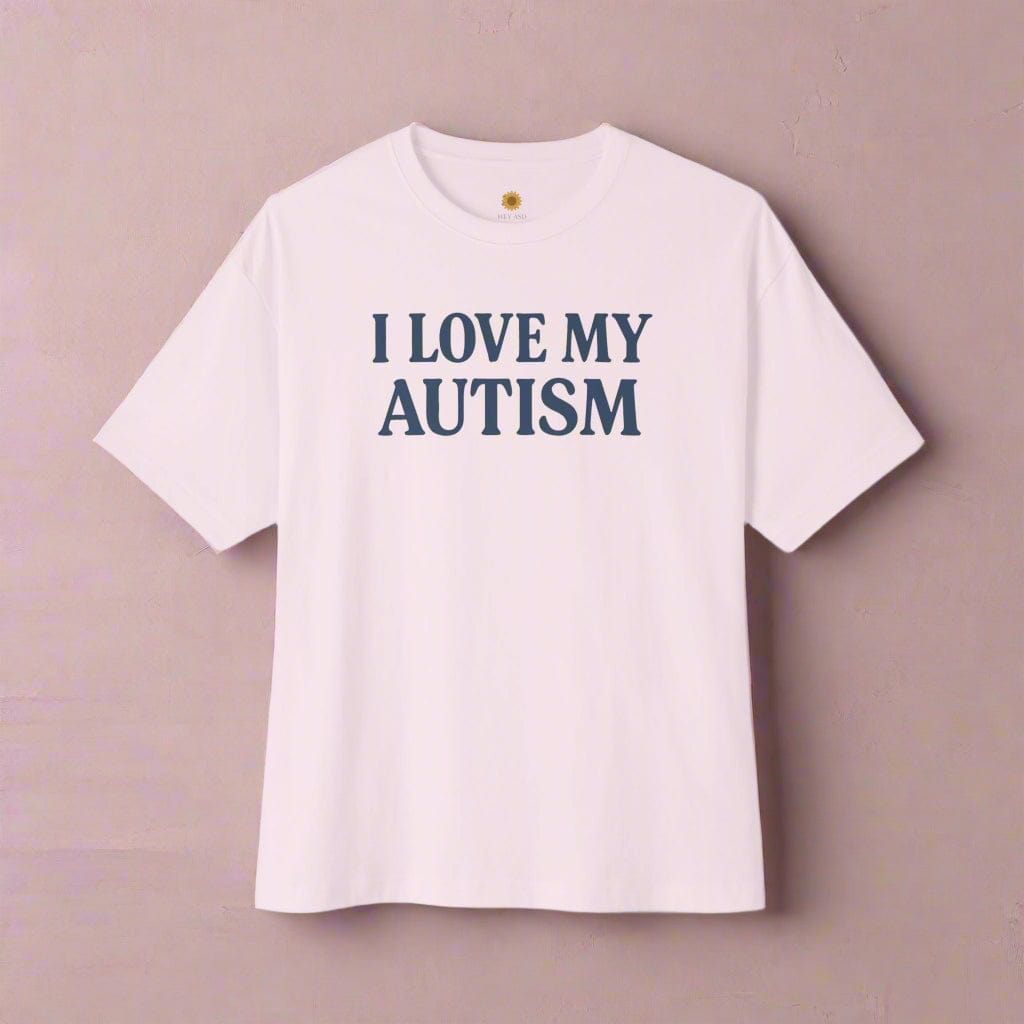Autism and Clothing Sensitivity: Finding Comfort That Feels Right

Written by the HeyASD Editorial Team
That constant scratch of a tag, the stiff pressure of a seam, the cling of a synthetic fabric — for many autistic adults, getting dressed can feel like preparing for battle. This isn’t fussiness; it’s a real sensory response from a nervous system that notices more and tires faster. If you’re searching for relief, our sensory-friendly autism clothing is designed to feel soft, breathable, and calm — so your outfit supports you instead of draining you.
In this guide, we’ll explain what clothing sensitivity feels like, why it happens, and the practical steps you can take to build a wardrobe that works with your body. You deserve comfort that feels right.
The Real Feel of Clothing Sensitivity in Autism
For autistic individuals, the sensory experiences tied to clothing can be intensely physical. What might be a minor annoyance for a neurotypical person can feel like a constant, painful distraction. This heightened reaction to sensory input isn't an exaggeration; it’s a genuine neurological response.
This ongoing discomfort can make simple daily activities feel draining. Below, we'll explore what this feels like from a lived-experience perspective, moving beyond simple descriptions to the emotional and physical reality of navigating a world not built for your sensory profile.
Living With an Itch No One Else Sees
Imagine an itch that you can’t scratch because it’s woven into the fabric of your shirt. This is a daily reality for many autistic people. It’s a form of sensory discomfort that feels like wearing sandpaper when everyone else seems to be wearing silk. The constant sensory stimulation from a rough texture or a poorly placed seam isn't just irritating; it can be physically painful.
This is why some autistic people have such strong reactions to clothes. Their nervous systems process intense sensory stimuli differently, amplifying the feeling of a tag, the tightness of a waistband, or the texture of a synthetic fabric. It’s a persistent, distracting signal that your body is trying to protect you from.
As one autistic adult shared, “I used to think I was just fussy—until I realized my body was protecting me.” This feeling is a protective response to something that genuinely feels harmful or overwhelming to your system.
Beyond “Picky”—Understanding Sensory Overload
The term “picky” doesn't begin to cover the experience of clothing sensitivity. It’s not about style or preference; it's about managing sensory input to prevent sensory overload. When your brain receives too much tactile information from your clothes, it can become overwhelmed, leading to exhaustion, anxiety, or even a meltdown.
You can often identify hypersensitivity to clothing by observing reactions. Does your child constantly pull at their clothes, complain of itching or pain, or have meltdowns before getting dressed? They may refuse to wear certain items altogether or seem distressed and distracted when wearing them. These are not behavioral issues but signs of genuine discomfort stemming from their unique sensory experiences.
Many autistic adults have spent years masking this discomfort, learning to “push through” the pain because they were taught their feelings were an overreaction. Recognizing these feelings as a valid response to sensory overload is the first step toward finding relief.
When Getting Dressed Feels Like a Challenge
For many autistic people, daily routines are a source of comfort and predictability. However, when that routine includes getting dressed in uncomfortable clothing, it becomes a major source of stress. This daily battle can drain your energy before the day has even begun, turning a simple task into a significant sensory challenge.
The sensory issues associated with clothing can make you feel like you have to choose between presenting yourself to the world and feeling safe in your own body. This is especially true when transitioning between seasons, as the change can disrupt an established, comfortable routine.
Soft, breathable, and natural fabrics are often best. Materials like organic cotton, bamboo, and soft knit fabrics put less stress on the sensory system. Seamless designs and tagless garments are also key, as they eliminate the small but significant irritants that can cause major discomfort. Finding these fabrics can transform the entire experience of getting dressed.
Emotional Impact—Frustration, Fatigue, and Shame
The emotional impact of clothing sensitivity is profound and can affect daily lives in unseen ways. The constant battle with your wardrobe is exhausting. It can lead to feelings of frustration when you can't find anything that feels right, fatigue from masking your discomfort all day, and even shame for not being able to tolerate "normal" clothes.
This struggle can limit your ability to participate in social events, work, or hobbies. You might avoid situations where you can't wear your "safe" clothes, leading to isolation. The emotional toll includes:
-
Constant Anxiety: Worrying about having to wear something uncomfortable.
-
Physical and Mental Exhaustion: Using up valuable energy just to tolerate your outfit.
-
Feeling Misunderstood: Being labeled as difficult or dramatic by others.
Effective coping strategies involve validating these feelings and proactively seeking solutions. Managing sensory aversions starts with prioritizing comfort and creating a wardrobe that works for you, not against you. This might mean finding specific brands you trust or modifying existing clothes to meet your needs.
What Causes Clothing Sensitivity in Autistic People?
Clothing sensitivity in autistic individuals stems from differences in sensory processing. Your brain interprets sensory information from the world differently, including touch. This isn't a flaw; it's a unique wiring that can make you more perceptive to details that others might not even notice, from the texture of a thread to the weight of a fabric.
Understanding the science behind these sensory needs can be empowering. It validates that your experiences are real and rooted in your neurology. Let's look at how sensory processing, interoception, and nervous system responses all play a role in how clothes feel on your body.
The Science of Sensory Processing and Touch
Sensory processing is how your nervous system receives messages from the senses and turns them into responses. For autistic people, the tactile system—which governs touch, pressure, and temperature—can be particularly sensitive. Your brain may amplify sensory input from clothing, making a soft cotton feel abrasive or a light seam feel like a sharp ridge.
This is why an autistic person might have an extreme reaction to a new shirt. Their brain isn't just registering "new shirt"; it's processing an overwhelming flood of new sensory input—the fabric's texture, the chemical smell, the way it moves. A research team studying sensory garments found that these sensitivities significantly impact daily life.
It's not a behavioral choice but a neurological reality. Your system is designed to notice more, feel more, and react more strongly to protect itself from what it perceives as a threat, even if that "threat" is just a polyester blend.
Interoception, Proprioception, and Why Clothes Can Distract
Beyond touch, two other senses are key to understanding clothing sensitivity: interoception and proprioception. These internal senses can be significantly affected by external sensory stimuli like clothing.
-
Interoception: This is your sense of what's happening inside your body, like hunger, thirst, or the need to use the restroom. When your brain is overwhelmed by uncomfortable clothing, it can be hard to hear these internal signals, leading to disconnection from your body's needs.
-
Proprioception: This is your sense of body awareness—knowing where your limbs are in space. Some autistic people find that snug-fitting layers or compression garments provide calming proprioceptive input, helping them feel more grounded and secure. Conversely, loose, shifty fabrics can be disorienting.
Sensory garments, like compression tees or seamless socks, can improve daily participation by either reducing distracting sensory stimuli or providing organizing input. This helps free up mental resources, allowing for better focus on tasks and social engagement.
Nervous System Overload and Protective Responses
At its core, clothing sensitivity is a function of the nervous system. An autistic nervous system is often in a heightened state of alert, constantly scanning for potential threats. Uncomfortable clothing is registered as one of these threats, triggering a protective response. This can look like pulling off clothes, avoiding certain textures, or having a meltdown.
This isn't a conscious decision to be difficult. It's an automatic, physiological reaction to sensory overload. Think of it as your body's alarm system being extra sensitive. While others' alarms might not go off for a scratchy tag, yours does—loudly.
Over time, it is possible to reduce the impact of clothing sensitivity. This is often achieved not by "toughening up" but by creating a safe and predictable sensory environment. Gradually introducing new textures in a low-stress way, paired with trusted comfort items, can help. However, the most effective method is honoring your sensory needs by choosing clothes that don't trigger the alarm in the first place.
Comparing Typical and Autistic Sensory Reactions to Clothing
The difference between how the general population and autistic individuals experience clothing can be stark. What is a minor issue for one can be a major barrier for the other. Understanding these different sensory responses is crucial for building empathy and finding effective solutions.
Common signs of clothing-related discomfort in autistic individuals include constant fidgeting, pulling at seams or tags, refusing to wear certain items, and expressing physical pain. These reactions go far beyond simple dislike.
Here’s a comparison to illustrate the difference:
|
Clothing Feature |
Typical Sensory Response |
Autistic Sensory Response |
|---|---|---|
|
Clothing Tag |
Mild annoyance, easily ignored or forgotten. |
A persistent, sharp, scratching sensation that is impossible to ignore and can cause distress. |
|
Seam on a Sock |
Barely noticeable. |
Feels like a rock in the shoe; a constant, painful pressure point. |
|
Wool Sweater |
May feel a little scratchy at first. |
Feels like wearing sandpaper or fiberglass; can cause physical pain and sensory overload. |
|
Tight Waistband |
A minor restriction. |
Can feel suffocating, causing anxiety and contributing to proprioceptive confusion. |
Common Clothing Triggers for Autistic Adults
Identifying your specific sensory triggers is a powerful step toward reclaiming your comfort. While everyone’s sensory needs are unique, many autistic adults report similar issues with their clothing choices. These triggers often come down to small details that clothing manufacturers overlook.
By becoming aware of these common culprits, you can start to make more informed decisions when shopping. This allows you to build a wardrobe that supports your well-being instead of causing distress. Let's explore some of the most frequent sources of clothing-related discomfort.
What Fabrics and Features Often Cause Discomfort?
The material of a garment is often the first and most significant hurdle. Certain fabrics are notorious for causing sensory challenges due to their texture, stiffness, or inability to breathe. For many autistic people, the wrong fabric can feel like a constant, irritating source of sensory input.
Some of the most common offenders include:
-
Rough Fabrics: Wool, stiff denim, and many synthetic blends like polyester or acrylic can feel abrasive against the skin.
-
Non-Breathable Materials: Fabrics that trap heat and moisture can lead to discomfort, especially for those with temperature sensitivities.
-
Inconsistent Textures: Clothing with sequins, beading, or rough embroidery can create unpredictable and overwhelming sensations.
The best fabrics are typically those that are soft, smooth, and predictable. Natural fibers like 100% cotton, bamboo, and modal are often preferred. Soft knit fabrics, especially those used in high-quality autism t-shirts, provide a gentle and consistent texture that minimizes negative sensory input and helps regulate the body.
Tags, Seams, and Stitching: Small Details, Big Difference
It’s often the smallest details of a garment that cause the biggest problems for people with tactile sensory sensitivities. A single tag or a bulky seam can render an otherwise perfect piece of clothing completely unwearable.
These features create focused points of pressure and friction that the autistic nervous system can interpret as painful or threatening. For example, a standard seam has a raised edge that can rub and chafe, while a tag’s sharp corners can feel like a constant poke. These sensory experiences accumulate throughout the day, draining energy and causing distress.
This is why sensory-friendly clothing brands, like HeyASD, focus on these details. By offering tagless labels and using flat seams, they eliminate these common irritants. Choosing garments with these features is a simple but powerful way to create more positive sensory experiences with clothing and build a wardrobe that feels truly comfortable.
Temperature, Texture, and Personal Boundaries
Clothing is our most immediate environment, and for autistic individuals, it needs to be a safe one. Sensitivities to temperature and texture are deeply connected to a sense of personal safety and bodily autonomy.
The feeling of being too hot or too cold can cause significant sensory discomfort and anxiety. Clothes that don't breathe well or that aren't suitable for the weather add another layer of distressing sensory stimuli. Similarly, textures that cling, bunch, or shift unexpectedly can feel like a violation of personal space. This is why some autistic people may remove their clothes—it's a direct attempt to escape overwhelming discomfort and regain a sense of control over their body.
To help prevent this, consider the following:
-
Layering: Offer lightweight, breathable layers that can be easily added or removed to manage temperature.
-
Predictable Fits: Choose clothing with a gentle, consistent fit that doesn't cling or restrict movement.
Laundry Products and Sensory-Friendly Care
The sensory experience of clothing doesn't end with fabric and fit; it extends to how it's cared for. Laundry products, like detergents and fabric softeners, can leave behind residues and scents that are overwhelming for sensitive noses and skin.
A strong, artificial fragrance can be just as disruptive as a scratchy seam. For many autistic people, these scents are a constant, unavoidable sensory assault. Stiff fabrics that haven't been softened properly can also be a major trigger. Managing clothing aversions includes thinking about the entire lifecycle of a garment.
Here are a few tips for sensory-friendly laundry care:
-
Use Unscented Products: Opt for fragrance-free, hypoallergenic detergents and avoid fabric softeners with strong smells.
-
Wash Before Wearing: Always wash new clothes to remove sizing chemicals and soften the fabric. An extra rinse cycle can help ensure all detergent is removed.
Sometimes, a favorite shirt just needs a sensory break from harsh chemicals to feel safe again. Honoring these sensory needs is a key part of creating a comfortable life.
Recognizing Signs of Clothing Sensitivity
Learning to recognize the signs of clothing sensitivity—in yourself or someone you care for—is a crucial act of validation. These signals are a form of communication, telling you that there is sensory discomfort. For many autistic individuals, especially those who are late-diagnosed or have a history of masking, these signs may be subtle.
However, once you know what to look for, the signs become clear. They can manifest physically, emotionally, and behaviorally. Paying attention to these cues helps you respond with compassion and practical support instead of confusion or frustration.
Physical Signals—Red Marks, Itching, or Pulling at Clothes
The body often shows the first and most obvious signs of clothing-related sensory challenges. These are not just fidgets; they are direct physical signs of a struggle against uncomfortable sensory input.
If you notice red marks on the skin where seams or waistbands have been, it's a clear indicator that the pressure is too much. Constant itching, even when there's no visible rash, is another sign that the fabric's texture is causing a negative reaction. One of the most common signs is constantly pulling at collars, sleeves, or socks, trying to create space between the skin and the irritating material.
Look for these physical signals:
-
Visible Irritation: Red lines along seam lines or from tags.
-
Repetitive Actions: Constantly adjusting, pulling, or tugging at specific parts of an outfit.
These actions are an attempt to self-regulate and minimize discomfort. Recognizing them as valid communication is the first step toward finding a solution.
Emotional Cues—Distress, Meltdowns, or Masking Discomfort
Emotional cues are another powerful indicator of clothing sensitivity. For autistic individuals, the relentless discomfort of the wrong clothes can easily lead to sensory overload, which may manifest as sudden distress, irritability, or a full meltdown. Getting dressed or being asked to wear a certain outfit can become a major point of conflict.
For autistic adults, especially those who have learned to mask their needs, the signs might be more internalized. They might become withdrawn, quiet, or seem unusually fatigued. This is because they are using an immense amount of energy to suppress their discomfort and "act normal."
To identify hypersensitivity, watch for these emotional cues:
-
Unexplained Anxiety or Irritability: Particularly before leaving the house or during transitions.
-
Avoidance: A strong refusal to wear certain clothes, even if they were worn before.
These are not "bad behaviors," but clear emotional responses to being in a state of sensory distress.
Changes in Participation and Social Engagement
When you're constantly battling sensory discomfort from your clothes, it's hard to focus on anything else. This can have a significant impact on your ability to participate in daily activities and social engagement. You might find it difficult to concentrate at work or school, or you may avoid social gatherings altogether because you don't have the energy to manage both your clothes and the social demands.
Sensory garments can dramatically improve participation by removing this barrier. When clothing feels safe and comfortable, it frees up cognitive and emotional resources. Instead of the brain focusing on the "threat" of a scratchy seam, it can focus on learning, playing, or connecting with others.
For children and adults alike, wearing something that feels good is a form of regulation. It calms the nervous system, reduces sensory discomfort, and makes it possible to show up in the world more fully and authentically.
Hypersensitivity Versus Hyposensitivity—Spotting the Difference
Sensory processing differences in autism aren't just about being overly sensitive (hypersensitivity). Some autistic people experience hyposensitivity, meaning they are under-responsive to sensory input. Understanding the difference is key to finding the right strategies.
-
Hypersensitivity (Over-Responsive): This is the experience of feeling things too intensely. People with hypersensitivity avoid certain textures, prefer loose clothing, and are easily irritated by seams and tags. The goal is to decrease sensory input. Soft, seamless, and tagless clothing is ideal.
-
Hyposensitivity (Under-Responsive): This involves a need for more intense sensory input to feel regulated. People with hyposensitivity may seek out heavy fabrics, tight clothing, or weighted blankets. They might not notice if their clothes are twisted or if they are hot or cold. Here, compression garments or snug layers can provide calming deep pressure.
Many autistic people experience a mix of both. Spotting the difference helps you choose clothing that either calms and protects (for hypersensitivity) or grounds and organizes (for hyposensitivity).
Strategies for Everyday Sensory Comfort
Finding everyday sensory comfort is not a luxury; it's a necessity for well-being. By adopting practical coping strategies, you can transform your relationship with clothing from a source of stress to a source of regulation. It’s about building a toolkit of options that honor your body’s needs.
These strategies empower you to take control of your sensory environment. From choosing the right fabrics to building a predictable wardrobe, each small adjustment can make a huge difference. Let's explore some gentle, effective ways to infuse more comfort into your daily life.
Finding Soft, Breathable, Sensory-Friendly Fabrics
The foundation of a comfortable wardrobe is the fabric itself. Prioritizing sensory-friendly fabrics is the single most effective strategy for reducing clothing-related stress. Your skin is your largest organ, and its sensory needs deserve to be respected.
Look for materials that are known for their softness and consistency. Soft knit fabrics are often a great choice because they stretch and move with the body without causing friction. Natural fibers also tend to be more breathable, which is crucial for temperature regulation.
When shopping, consider these options:
-
100% Cotton: Especially Pima or combed cotton, which have longer, softer fibers.
-
Bamboo or Modal: These are known for their silky-smooth texture and moisture-wicking properties.
Avoid scratchy materials like wool and stiff synthetics like polyester whenever possible. Reading labels and touching fabrics before you buy can help you make choices that align with your sensory needs.
Customizing and Modifying Everyday Clothing
You don't always have to buy new clothes to find comfort. Sometimes, the best solution is to modify the clothing you already have. This is a practical and empowering way to overcome sensory challenges and expand your clothing choices.
The most common modification is removing tags. Use a seam ripper for a clean removal that won't leave a scratchy stub behind. You can also turn clothes inside out if the seams are smoother on the outside or wear a soft base layer underneath a more textured garment.
Here are a few more ideas:
-
Replace Closures: Swap out difficult buttons or zippers for magnetic snaps or soft Velcro for more comfortable closures.
-
Soften Fabrics: Wash stiff items like new jeans multiple times with a gentle, unscented detergent to break them in.
These small customizations can make a world of difference, turning an unwearable item into a trusted favorite.
Building a Wardrobe of Predictable Favorites
For many autistic people, predictability is comfort. This applies to daily routines, and it absolutely applies to your wardrobe. Having a small collection of trusted, comfortable favorites can significantly reduce the stress of getting dressed.
This doesn't mean your wardrobe has to be boring. It means finding what works for you and sticking with it. Once you find a brand or style of shirt, pants, or socks that feels good, buy it in multiple colors. These essential basics form the core of a sensory-safe wardrobe.
To build your collection of favorites:
-
Create a "Uniform": Find a go-to outfit formula that you know is comfortable and makes you feel good.
-
Organize for Ease: Keep your favorite items in a dedicated "sensory-safe drawer" so you can always find them easily, especially on high-stress days.
This approach simplifies decision-making and guarantees a comfortable start to your day, every day. It's one of the most effective ways to manage sensory aversions long-term.
Empowering Autistic Adults to Choose Comfort
Ultimately, the most powerful strategy is empowerment. For too long, many autistic adults have been told their sensory needs are an inconvenience. It's time to unlearn that message and unapologetically prioritize sensory comfort.
Choosing comfort is an act of self-advocacy and self-care. It's about giving yourself permission to wear what feels good, regardless of trends or external expectations. When you honor your sensory needs, you conserve energy for the things that truly matter to you.
Here’s how you can empower yourself:
-
Trust Your Body: Your discomfort is real and valid. If something doesn't feel right, you don't have to wear it.
-
Communicate Your Needs: If helpful, explain to loved ones why you choose certain clothes. For example, "This soft fabric helps me stay calm."
Sensory garments and comfortable clothing aren't a crutch; they are a tool. A tool that helps you regulate, participate, and thrive. And when you find something that feels right, it’s not just clothing—it’s regulation.
Solutions: Sensory-Friendly Clothing for Autism
The good news is that you are not alone in your search for comfort. A growing number of brands are beginning to recognize the need for sensory-friendly clothing. These companies are moving beyond aesthetics to design clothes that truly support the sensory needs of the autistic community.
This shift means more options that are intentionally designed to reduce negative sensory stimuli. From autism hoodies with soft interiors to tagless t-shirts, the sensory world of fashion is slowly becoming more accessible. Let's explore what makes this clothing different and how to find the best options for you.
What Makes a T-Shirt Sensory-Safe?
A truly sensory-safe t-shirt is designed with intention, focusing on details that are often overlooked by mainstream brands. It’s about more than just being made of cotton; it’s about creating a smooth, predictable, and non-irritating experience for the wearer.
The first hallmark is the fabric. A sensory-safe shirt uses premium, soft knit fabrics that feel gentle and consistent against the skin. They are breathable and have a slight stretch, allowing for free movement without constriction.
Key features of a sensory-safe t-shirt include:
-
Tagless Labels: The label information is printed directly onto the fabric, eliminating the number one source of irritation.
-
Flat Seams: The seams are sewn flat so they don't create a raised, scratchy ridge against the skin.
Brands like HeyASD are dedicated to these principles, creating autism t-shirts that prioritize comfort from the very first stitch.
How Hey ASD’s Community-Created Pieces Support Comfort
What sets HeyASD apart is that our pieces are designed by autistic adults who have a deep, personal understanding of what sensory comfort really means. We don't just guess what might feel good; we create clothing based on our own lived experiences with sensory needs. This community-first approach is at the heart of everything we do.
Our goal is to ease the discomfort of wearing typical clothing. Each design element is a direct response to a common sensory challenge. We believe that clothing should be a source of expression and joy, not pain.
Our pieces support comfort through:
-
Lived Experience: We know the pain of a scratchy tag and the relief of a perfectly soft fabric.
-
Empowering Messages: Our designs celebrate autistic identity and pride, helping you feel good both inside and out.
At HeyASD, every piece is more than just clothing—it's a piece of community support, designed to make your world a little softer.
Tips for Shopping: Features to Look for and Avoid
Shopping for sensory-friendly clothing can feel overwhelming, but knowing what to look for makes it much easier. Whether you're shopping online or in a store, keeping a mental checklist of features can help you make choices that honor your individual preferences.
You can find adaptive and sensory-friendly clothing at specialized online stores, and increasingly, within dedicated sections of larger retailers. Brands like HeyASD offer a curated collection created specifically for the autistic community, taking the guesswork out of finding comfortable options.
When you shop, look for these features:
-
Look For: Tagless labels, flat seams, soft and breathable fabrics (like cotton or modal), and gentle fits.
-
Avoid: Stiff fabrics (like non-stretch denim or polyester), bulky seams, decorative elements like sequins, and tight, restrictive collars or waistbands.
-
Read Reviews: Check what other autistic people are saying about the texture and fit of a garment.
Explore our sensory-friendly t-shirts—designed by autistic creators who care deeply about comfort and self-expression.
Key Takeaways: Autism and Clothing Sensitivity
- Clothing sensitivity is real—a neurological response to overwhelming tactile input, not a sign of fussiness.
- Common triggers include tags, seams, rough fabrics, and strong laundry scents that overload the senses.
- Comfort supports regulation—when clothing feels safe, energy can be directed toward focus and connection.
- Sensory-friendly design matters: tagless labels, flat seams, soft natural fibers, and breathable fits reduce daily stress.
- Autistic-made clothing empowers—Hey ASD’s pieces are designed from lived experience so you can feel comfortable, confident, and seen.
Comfort Isn’t a Luxury — It’s Regulation
Clothing sensitivity is not a personal failing; it’s a valid sensory experience. When tags, seams, and rough fabrics stop competing for your attention, you free up energy for focus, connection, and joy. Prioritize fabrics and fits that feel gentle and predictable, remove irritants where you can, and give yourself permission to choose comfort every single day.
If you’re ready for pieces that are designed from lived experience — soft knits, tagless labels, and flat seams — explore our curated range of autism clothing. Here, the world bends to meet you.
Find Clothing That Feels Right
Designed by autistic adults for autistic adults — soft, tagless, breathable, and made to soothe rather than scratch.
Explore Clothing Made for Autistic AdultsFrequently Asked Questions
How can I tell if sensory-friendly clothing is right for me or my child?
If you or your autistic child struggle with clothing-related sensory issues—like irritation from tags, seams, or fabrics—then sensory-friendly clothing is likely a great fit. If getting dressed causes distress or impacts daily lives, switching to clothes designed to decrease negative sensory input can make a significant, positive difference.
Can clothing sensitivity change or improve over time?
While underlying sensory processing differences are a lifelong part of being on the autism spectrum, the impact of clothing sensitivity can lessen. By using coping strategies, creating a comfortable environment, and mindfully choosing sensory-friendly clothes, you can significantly reduce daily distress and improve your tolerance over time.
Where can I buy adaptive or sensory-friendly clothes in the United States?
You can find sensory-friendly and adaptive clothes through specialized online retailers and brands created by and for the autistic community, like HeyASD. Some larger department stores are also beginning to carry adaptive lines. Always shop from secure websites and check reviews from other community members to find the best options.
What are some common clothing sensitivities experienced by individuals with autism?
Common sensory sensitivities for autistic individuals include extreme reactions to scratchy tags, bulky seams, and rough fabrics like wool or polyester. Tightness around the neck or waist, unpredictable textures, and strong laundry scents are also frequent sensory stimuli that can disrupt daily activities and cause significant discomfort.
How can I choose the right fabrics for someone with autism who has clothing sensitivities?
Focus on soft, breathable, and consistent textures. Soft knit fabrics, 100% cotton, bamboo, and modal are excellent choices. It's best to feel the fabric if possible, but when shopping online, read descriptions carefully. Honoring individual preferences is key, as one person's perfect fabric may differ from another's sensory needs.
Are there specific brands or stores that cater to sensory-friendly clothing for individuals with autism?
Yes, several brands now specialize in sensory-friendly clothing. HeyASD is a brand created by autistic adults specifically for our community, focusing on comfort and pride. Other companies also offer tagless, seamless, and soft-fabric options that are becoming an OT favorite for families seeking comfortable solutions.
What strategies can help ease the discomfort of wearing certain types of clothing for someone with autism?
Effective coping strategies include removing all tags, choosing clothes with flat seams and comfortable closures, and wearing a soft, trusted base layer under less comfortable items. Building a wardrobe of essential basics made from preferred fabrics helps decrease sensory input and ensures sensory comfort is always within reach.












